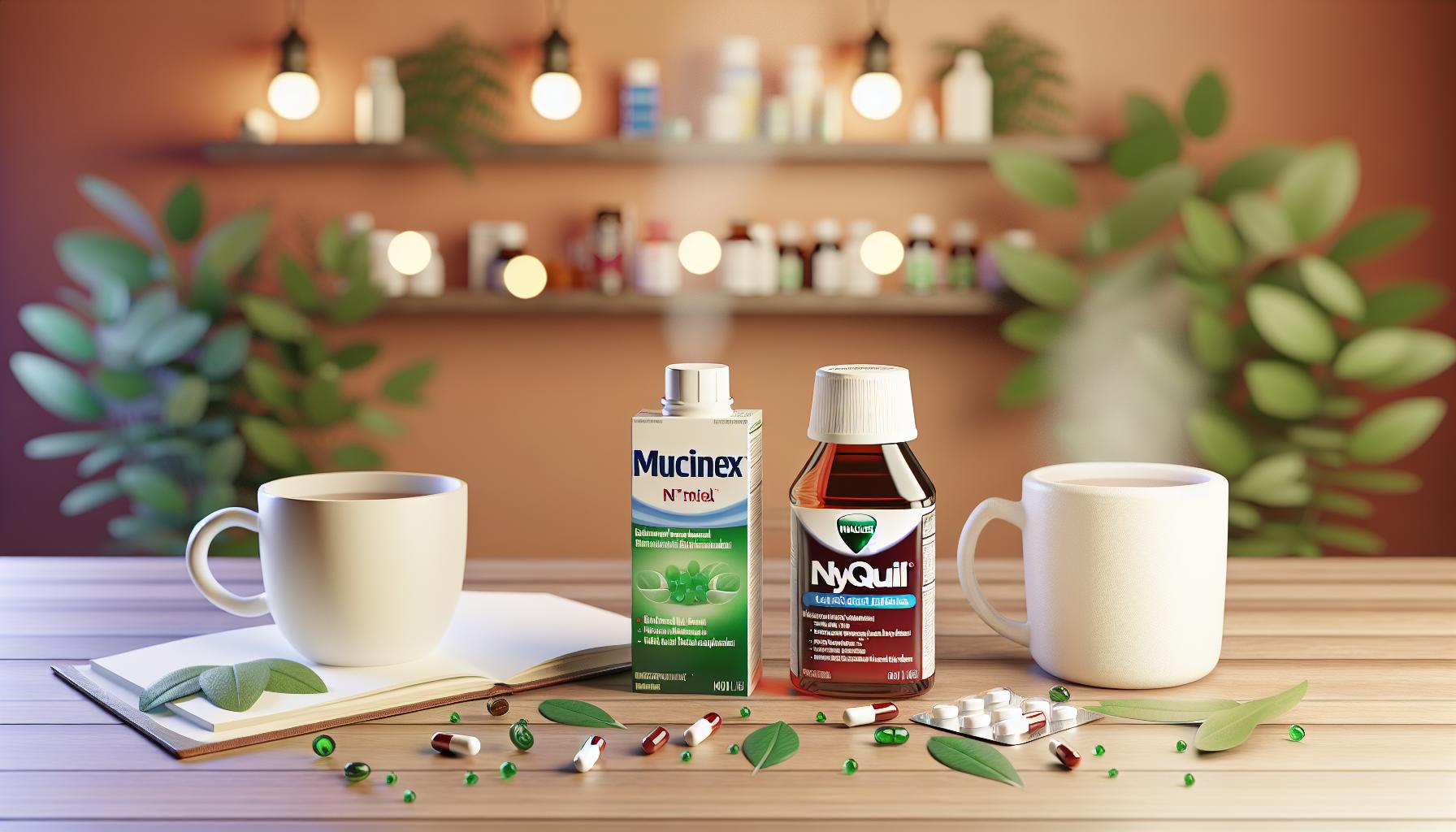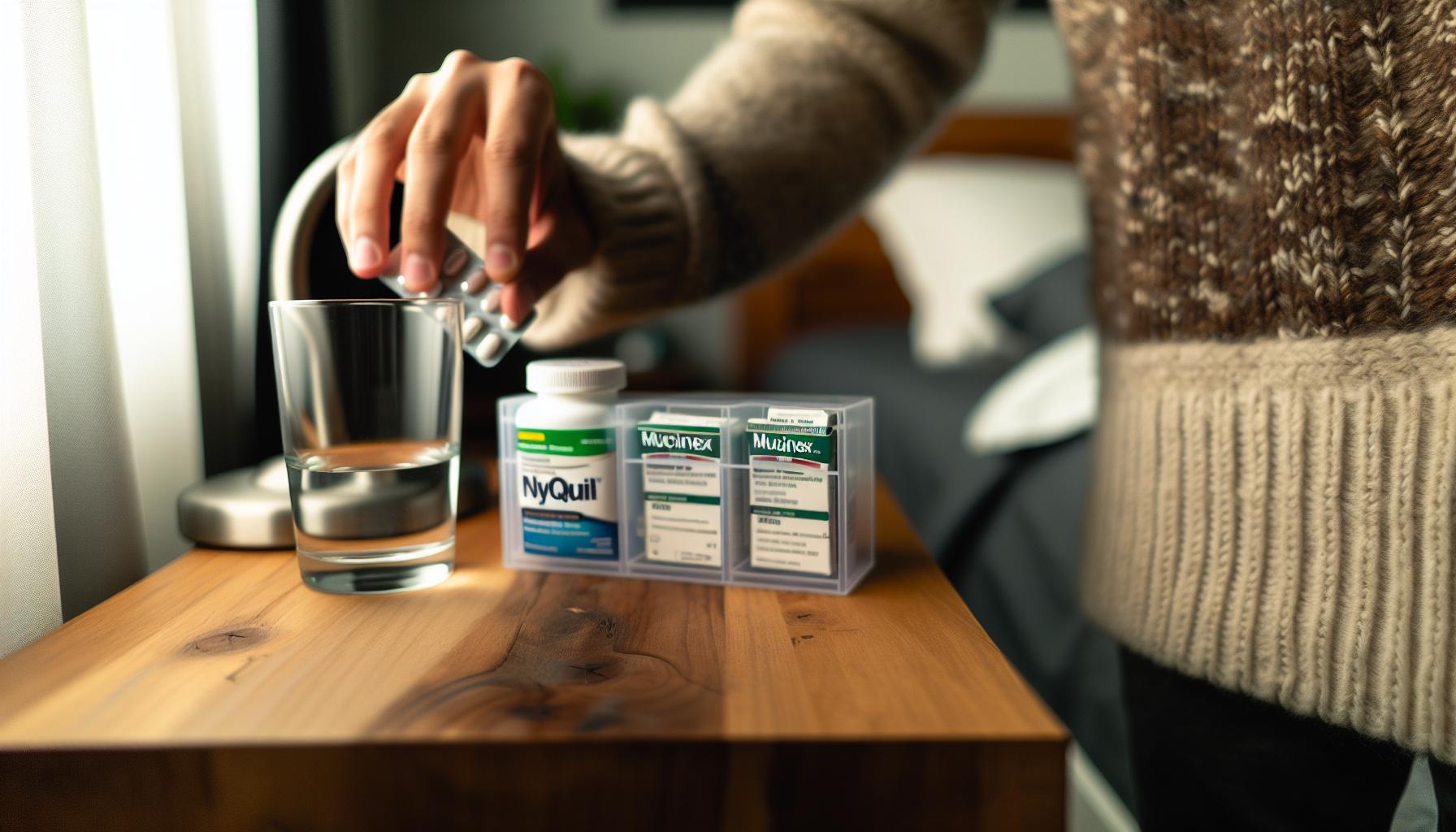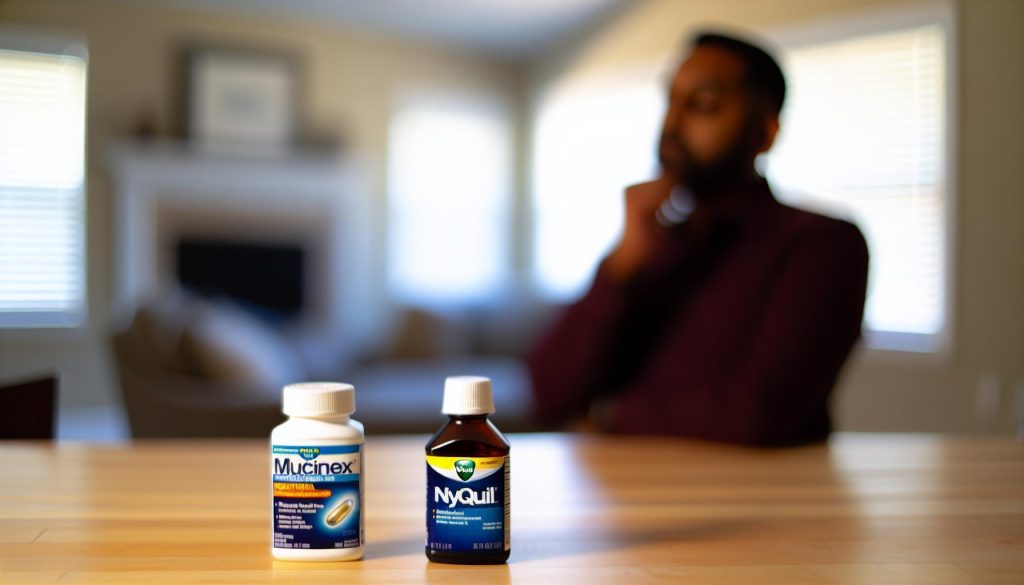When you’re feeling under the weather, reaching for over-the-counter medications like Mucinex and Nyquil can seem like a quick way to find relief. However, questions about their safety when taken together often arise. Mucinex, effective for loosening mucus, and Nyquil, which alleviates cold symptoms, may seem complementary, yet combining them requires careful consideration. Understanding how these medications interact is crucial, especially if you want to avoid adverse effects while effectively managing your symptoms. In this article, we’ll explore the safety of taking Mucinex and Nyquil together, helping you make informed decisions for your health. Stay tuned as we unravel the facts and empower you to navigate your cold or flu treatment safely.
Mucinex and Nyquil: An Overview of Active Ingredients

Mucinex and Nyquil are two of the most commonly used over-the-counter medications designed to alleviate cold and flu symptoms, but they contain different active ingredients that serve distinct purposes. Understanding these ingredients can help you make informed choices about your health, especially when considering whether to use them in conjunction.
Mucinex primarily contains guaifenesin, an expectorant that works to loosen and thin mucus in the airways, making it easier to cough up and clear out phlegm from the chest. This makes Mucinex particularly useful for alleviating productive coughs associated with respiratory infections. The goal is to promote more effective breathing and reduce the discomfort caused by accumulated mucus.
On the other hand, Nyquil typically combines multiple active ingredients to target various aspects of cold and flu symptoms. Commonly included components are acetaminophen (a pain reliever and fever reducer), dextromethorphan (a cough suppressant), and doxylamine (an antihistamine that aids with sleep and reduces sneezing and runny noses). Each ingredient plays a unique role in alleviating discomfort, such as reducing fever, suppressing coughs, and promoting restful sleep.
In summary, while Mucinex focuses on clearing mucus and making coughs more productive, Nyquil provides a multi-symptom approach to relieve pain, suppress coughs, and promote sleep. For individuals experiencing multiple symptoms, understanding these functions is crucial when determining the best treatment strategy. Always consider consulting a healthcare professional before combining these medications to ensure safety and appropriateness for your particular health conditions.
Understanding the Purpose: Mucinex vs. Nyquil
When faced with the discomfort of cold and flu symptoms, understanding the distinct roles of Mucinex and Nyquil can significantly enhance your treatment strategy. Each of these over-the-counter medications is formulated to target specific symptoms, allowing for tailored relief based on individual needs. Mucinex, which contains the active ingredient guaifenesin, functions primarily as an expectorant. This means its main purpose is to loosen and thin mucus in the respiratory tract, making it easier to cough up and clear phlegm. This is particularly beneficial for individuals experiencing a productive cough, where mucus buildup can hinder breathing and contribute to discomfort.
In contrast, Nyquil offers a multi-faceted approach to symptom relief through a combination of ingredients. Commonly found in Nyquil are acetaminophen, which alleviates pain and reduces fever; dextromethorphan, a cough suppressant that helps manage persistent coughs; and doxylamine, an antihistamine that combats sneezing and facilitates sleep. This blend of ingredients addresses multiple symptoms of cold and flu, from aching muscles and chills to sleep disturbances caused by a runny nose or cough.
Combining these medications can be tempting, particularly when multiple symptoms are present. However, it’s essential to consider their respective purposes and active ingredients. While Mucinex is ideal for those grappling with chest congestion, Nyquil targets various cold symptoms through its sedative and pain-relieving properties. Therefore, understanding when to use each medication can lead to more effective self-care. It is always wise to consult with a healthcare professional before mixing medications to ensure that any combined use does not lead to unexpected side effects or interactions, particularly for individuals with pre-existing health conditions or those taking other medications. By asking critical questions and seeking guidance, you can maximize your relief while minimizing potential risks.
Potential Interactions and Side Effects Explained

Mixing medications can often feel like navigating a maze, especially when it comes to over-the-counter remedies like Mucinex and Nyquil. Understanding the potential interactions and side effects of these drugs is crucial to ensure your safety and enhance your recovery process. Mucinex, with its active ingredient guaifenesin, primarily helps to break up mucus, while Nyquil serves a broader role in alleviating various symptoms, including fever, pain, and cough. These distinct purposes mean that careful consideration must be given when combining their use.
One significant aspect to be aware of is the risk of overlapping ingredients and their combined effects. For instance, Nyquil contains acetaminophen, which, when taken in excess, can lead to liver damage. If you’re already using other medications containing acetaminophen, adding Nyquil could push you over the safe dosage threshold. Furthermore, the sedative properties of Nyquil, due to its antihistamine component doxylamine, might cause increased drowsiness when taken alongside medications that already have a sedative effect. This can heighten the risk of accidents or impaired judgment.
It’s equally important to monitor for any potential side effects that may arise from mixing these medications. Common side effects of Mucinex can include nausea, vomiting, and dizziness, while Nyquil may cause dry mouth, drowsiness, and potential allergic reactions. These adverse effects can become more pronounced when taken together, leading to a compounded risk for reactions that might not be as severe when each medication is taken alone. If you experience severe headaches, mood changes, or signs of an allergic reaction such as hives or difficulty breathing, it’s vital to stop use immediately and consult a healthcare professional.
To sum up, while combining Mucinex and Nyquil may seem advantageous for addressing multiple symptoms, it comes with potential risks. To navigate this safely, always discuss with a healthcare provider before mixing these medications. They can provide personalized advice that considers your overall health, existing medical conditions, and any other medications you may be taking. Ensuring your safety while finding relief is paramount, and expert guidance can help you make informed decisions on your health journey.
When Is It Safe to Combine Mucinex and Nyquil?

While navigating the complexities of medication use, particularly during cold and flu season, understanding when it’s appropriate to combine Mucinex and Nyquil can be pivotal for your recovery. Both medications target different symptoms: Mucinex, containing guaifenesin, works to loosen mucus and make coughs productive, while Nyquil, with ingredients like acetaminophen and doxylamine, addresses pain, fever, and cough, often promoting sleep. This distinction highlights the importance of evaluating not just symptom relief, but also safety.
It may be safe to combine these medications in instances where individual symptoms genuinely require both therapies, but caution is essential. Firstly, check the active ingredients in Nyquil products, as some formulations contain additional components that may overlap with Mucinex. If you decide to combine them, ensure you’re not exceeding recommended dosages of acetaminophen, as this can lead to severe liver damage. Furthermore, being mindful of timing can help; for example, using Mucinex during the day for productive cough relief while reserving Nyquil for evening symptoms may provide effective management without excessive drowsiness or overlap.
Before considering this combination, always take stock of your overall health. Individuals with liver issues, respiratory conditions, or those who take other medications should consult a healthcare professional for personalized advice. Listening to your body is crucial; if you experience heightened side effects such as excessive drowsiness, confusion, or unusual reactions, discontinue use immediately and seek medical assistance. By prioritizing informed decision-making, you enhance your chances of a safe and effective recovery strategy tailored to your needs.
Dosage Guidelines for Mucinex and Nyquil

When navigating the complexities of dosages for Mucinex and Nyquil, it’s crucial to understand that taking the correct amounts can significantly impact your recovery while minimizing the risk of adverse effects. Mucinex, primarily containing guaifenesin, is typically dosed as follows: adults and children aged 12 and older should take 600 mg to 1200 mg every 12 hours, not exceeding 2400 mg in 24 hours. For children aged 6 to 11, the usual dose is 100 mg to 200 mg every 4 hours as needed, with a maximum of 600 mg per day.
On the other hand, Nyquil, which can vary in its active ingredients depending on the formulation, usually includes acetaminophen, dextromethorphan, and doxylamine. The general dosing guideline for adults and children over 12 years is 30 mL every 6 hours as needed, not exceeding 4 doses in 24 hours. It’s important to note that if you are taking other medications containing acetaminophen, you must ensure that the total daily dose does not exceed 3000 mg, or up to 4000 mg under a healthcare provider’s guidance, to avoid liver toxicity.
Key Considerations for Safe Use
To safely use both medications together:
- Always read the labels carefully for active ingredients to avoid doubling up on similar medications.
- Monitor your symptoms and the side effects of each medication, adjusting doses only as advised by a healthcare professional.
- Be particularly cautious if combining Nyquil with Mucinex that contains pseudoephedrine, as both can raise blood pressure.
Consult Healthcare Professionals
Before using Mucinex and Nyquil in combination, it’s advisable to consult with healthcare professionals, especially if you have existing health conditions or are on other medications. This is crucial for ensuring that dosages align well with your health needs and to prevent harmful interactions. By adhering to proper dosing guidelines and seeking professional advice, you empower your recovery process during cold and flu season.
Signs You Should Avoid Mixing These Medications
Combining medications can often feel like a juggling act, especially when dealing with cold and flu symptoms. Understanding when not to mix Mucinex and Nyquil is critical for safeguarding your health. Certain signs indicate that using these two medications together may not be wise. For instance, if you find yourself experiencing increased heart rate, elevated blood pressure, or excessive drowsiness, these could be red flags. Mixing Mucinex-which typically contains guaifenesin-and Nyquil’s various formulations, which may include sedating ingredients, can amplify these effects, leading to complications.
People with pre-existing medical conditions should exercise extra caution. Conditions like hypertension, heart disease, or liver issues can be exacerbated by the ingredients in these medications. If you’re already taking other medications that affect blood pressure or liver function, the risks of combining Mucinex and Nyquil can increase significantly. Always consult with a healthcare professional in these scenarios to ensure safe medication use.
It’s also essential to watch for any allergic reactions. If you’ve had sensitivities to any components in Mucinex or Nyquil, combining them could lead to serious reactions, including rash, itching, or difficulty breathing. If you’re uncertain about your allergies or past reactions, it’s best to err on the side of caution and seek professional advice before mixing these products.
Finally, if you’re consuming alcohol or other sedatives, it’s advisable not to mix Nyquil with Mucinex, particularly because both can cause sedation. This combination may lead to excessive drowsiness, impairing cognitive functions and motor skills. Recognizing these signs and being aware of your body’s responses helps in making informed choices about your health, ensuring that every step you take toward recovery is a safe one. Always prioritize speaking to healthcare professionals when in doubt about medication combinations.
Alternative Remedies for Cough and Cold Relief
When relief from cold and cough symptoms is sought, many often turn to over-the-counter medications like Mucinex and Nyquil, but there are also numerous natural remedies available that can provide comfort and support recovery without the potential complications of medication combinations. Exploring these alternatives can not only serve as effective treatments but also promote overall wellness.
Natural Remedies for Cough and Cold Relief
One popular approach is the use of herbal teas, which can be soothing for a sore throat and effective for easing cough symptoms. Teas made from ingredients like ginger, chamomile, or peppermint offer anti-inflammatory properties that may help relieve discomfort. Honey, added to these teas, not only sweetens the drink but is also known for its natural cough-suppressant effects. A warm honey-lemon drink is a classic remedy that promotes hydration while providing vitamin C, known for its immune-boosting benefits.
Another useful remedy is the inhalation of steam. Taking a hot shower or using a humidifier can help keep airways moist, which eases coughing and throat irritation. Adding essential oils like eucalyptus or tea tree oil may enhance this effect, contributing to easier breathing. Additionally, gargling warm salt water can reduce throat inflammation and provide temporary relief from soreness.
Dietary Considerations
Maintaining a healthy diet is crucial during illness. Consuming nutrient-rich foods like chicken soup, which provides warmth and hydration, has been traditionally recommended for cold relief. Foods rich in vitamins C and D, such as citrus fruits, bell peppers, and fortified cereals, can support immune function during bouts of cold and flu. Staying hydrated is equally important; drinking plenty of fluids, including water, herbal teas, and broths, helps thin mucus and keeps the throat moist.
Consulting Healthcare Professionals
While natural remedies can be beneficial, it’s important to approach them with caution, especially if you are concurrently using over-the-counter medications like Mucinex or Nyquil. Consulting with a healthcare professional can provide personalized advice, ensuring that any combination of treatments is safe and effective for your specific situation. This is especially true for individuals with underlying health conditions or those taking other medications, as certain natural components can interact with pharmaceuticals.
In conclusion, integrating natural remedies with proper medical guidance can enhance recovery from cough and cold symptoms. By focusing on hydration, nutrition, and safe alternative treatments, you can effectively support your health while potentially avoiding the risks that come with mixing medications. Always remember to prioritize communication with healthcare professionals about any healthcare courses you choose to explore.
Consulting Healthcare Professionals About Medication Use
Navigating the world of over-the-counter medications for managing cold and flu symptoms can be overwhelming, especially when considering combinations like Mucinex and Nyquil. With various active ingredients designed to target specific symptoms, understanding how these medications work together is crucial. Having a discussion with a healthcare professional can provide clarity and ensure that you make informed choices tailored to your health needs.
When consulting with a healthcare provider, it’s helpful to provide detailed information about your symptoms, any other medications you are currently taking, and your medical history. This information enables them to assess potential interactions effectively. For instance, both Mucinex (guaifenesin) and Nyquil commonly contain ingredients that may cause sedation or drowsiness, which could be concerning for individuals who need to operate machinery or perform tasks requiring full attention.
For certain populations, such as pregnant or breastfeeding individuals, or those with underlying health conditions like diabetes or hypertension, professional guidance is essential to navigate the complexities of medication safety. Understanding the timing of doses and how to properly assess symptom severity can empower individuals to make better choices.
Moreover, healthcare professionals can also recommend alternative treatments that may be more suitable or effective based on personal needs. Whether it’s lifestyle changes, dietary recommendations, or specific over-the-counter remedies, leveraging professional insight can enhance recovery and minimize the risk of adverse reactions. Always prioritize an open dialogue with your healthcare provider when considering your medication options; this can make all the difference in ensuring safe and effective relief from your cold or flu symptoms.
User Experiences: What People Are Saying
Many people turn to over-the-counter medications like Mucinex and Nyquil to cope with the discomfort of cold and flu symptoms, but experiences shared by users reveal a spectrum of outcomes. While some individuals have reported positive experiences, citing effective relief from nasal congestion and coughs, others express concern about potential interactions and side effects when combining these medications.
Users often highlight the importance of timing in their regimen. For instance, someone might share that they took Mucinex during the day to manage chest congestion effectively, finding it beneficial for keeping mucus at bay, while opting for Nyquil at night to help with sleep and alleviate symptoms that disrupt rest. These individual experiences emphasize a common strategy: using Mucinex to manage worsening symptoms during the day and reserving Nyquil for nighttime relief.
Moreover, many comments focus on the side effects of these medications. A user might recount feeling drowsy after taking Nyquil, which is common due to its sedating ingredients. In some cases, people were unaware of Mucinex’s potential for side effects like nausea when used at higher doses or in conjunction with other medications. These insights stress the need for careful consideration and awareness, urging readers to consult healthcare professionals for personalized advice about dosage and safety, especially when considering combining medications.
It’s clear from various testimonials that while Mucinex and Nyquil can both provide much-needed relief for cold and flu symptoms, users strongly recommend being cautious about how and when to use them together. Listening to one’s own body along with a healthcare provider’s guidance can help lead to a more effective and safe treatment strategy.
Expert Recommendations on Cold Treatments
When it comes to managing cold and flu symptoms, the right approach can make all the difference. Experts suggest that while over-the-counter medications like Mucinex and Nyquil can provide relief, understanding their ingredients and potential interactions is essential for safe and effective use. For instance, Mucinex, which contains guaifenesin, is primarily used to relieve chest congestion and promote mucus clearance, making it suitable for daytime use. In contrast, Nyquil, with its combination of ingredients designed to combat cough, runny nose, and sleeplessness, is often recommended for nighttime use due to its sedative effects.
Safe Usage Recommendations
Experts typically advise against using Mucinex and Nyquil together without consulting a healthcare provider. While some individuals may opt for this combination to tackle both daytime and nighttime symptoms, doing so can increase the risk of side effects, particularly drowsiness and nausea. Always consider the following key points before mixing these medications:
- Review Active Ingredients: Ensure you are aware of all active ingredients in both medications. For example, Nyquil contains diphenhydramine, which can cause significant sedation and may compound Mucinex’s side effects.
- Monitor Dosage: Stick to the recommended dosages for both medications. Avoid exceeding the maximum dose of Mucinex to prevent gastrointestinal disturbances.
- Consult Healthcare Professionals: Always involve a healthcare provider when considering combinations, especially if you have pre-existing conditions or are taking other medications that could interact poorly.
General Advice for Cold Treatment
In addition to medication, experts suggest various strategies to enhance recovery from cold and flu symptoms. Staying hydrated is crucial; drinking plenty of fluids helps thin mucus and keeps the throat moist. Additionally, rest plays a vital role in recovery-allowing your body time to fight off the infection is as important as medication. Natural remedies such as honey, warm teas, and saline nasal sprays can also provide relief without the associated risks of drug interactions.
By following these guidelines and remaining mindful of your body’s reactions, you can navigate the complexities of cold and flu treatments more effectively. Remember, when in doubt, seek personalized advice from healthcare professionals who can provide tailored recommendations based on your individual health needs.
Understanding Cold and Flu Symptoms: When to Seek Help
Recognizing when to seek medical attention during a cold or flu can significantly impact the recovery process. Many individuals experience symptoms that are mild and manageable with over-the-counter remedies, but there are critical signs that indicate when professional help is necessary. For instance, if a cold evolves into a severe cough or if you develop a high fever that persists beyond a few days, it’s essential to consult a healthcare professional.
Some symptoms warrant immediate attention. If you experience difficulty breathing, chest pain, or persistent vomiting, you should seek emergency care. Furthermore, individuals with underlying health conditions, such as asthma, diabetes, or compromised immune systems, are at greater risk and should be more vigilant. Older adults and young children are also particularly vulnerable and may exhibit symptoms that escalate quickly.
Here are some specific symptoms to monitor closely:
- High Fever: A temperature above 102°F (38.9°C) that lasts more than three days.
- Severe Headaches: Intense headaches that do not respond to typical pain relievers.
- Shortness of Breath: Difficulty in breathing or persistent wheezing.
- Chest Pain: Sharp or continuous pain that is concerning or unusual.
- Confusion: Sudden mental changes, such as confusion or decreased alertness.
In addition to monitoring symptoms, properly communicating with your healthcare provider about the medications you’re taking, including Mucinex and Nyquil, can help ensure safe and effective treatment. If you find that your symptoms are not improving after several days of treatment, or if they worsen, it’s crucial to seek medical advice. Early intervention can prevent complications and promote a quicker recovery.
Q&A
Q: Can Mucinex and Nyquil be taken together without risks?
A: It is generally advised to avoid taking Mucinex and Nyquil together due to potential overlapping ingredients and increased risk of side effects. Always consult a healthcare provider before combining medications to ensure safety and effectiveness.
Q: What are the potential side effects of taking Mucinex with Nyquil?
A: Combining Mucinex and Nyquil can increase the risk of side effects such as dizziness, drowsiness, and gastrointestinal upset. Always monitor how you feel and consult a healthcare professional if side effects occur.
Q: When is it safe to use Mucinex and Nyquil together?
A: Using Mucinex and Nyquil concurrently may be safe under certain conditions, such as specific dosages and individual health considerations. It’s crucial to consult a healthcare provider to determine the appropriateness of this combination.
Q: What ingredients in Mucinex might interact with Nyquil?
A: The active ingredient in Mucinex is guaifenesin, while Nyquil often contains dextromethorphan and diphenhydramine. These may interact in ways that amplify side effects, particularly sedation and respiratory depression.
Q: Are there alternatives to Mucinex and Nyquil for cold relief?
A: Yes, alternatives include natural remedies like honey, herbal tea, and saline nasal sprays. Discuss these options with a healthcare professional to find the best solution tailored to your symptoms.
Q: How can I safely manage cold symptoms without Mucinex or Nyquil?
A: Hydration, rest, and over-the-counter options like saline sprays or non-drowsy antihistamines can help manage symptoms without the risks associated with Mucinex and Nyquil. Always seek advice from a healthcare provider for tailored recommendations.
Q: What should I do if I accidentally mix Mucinex and Nyquil?
A: If you accidentally take both medications, monitor for any adverse reactions. If you experience unusual symptoms, contact a healthcare provider or poison control center immediately for guidance.
Q: How can I find out if Mucinex and Nyquil are safe for me?
A: To determine the safety of using Mucinex and Nyquil together, consult with a healthcare professional who can assess your medical history, current medications, and specific symptoms to provide personalized advice.
In Retrospect
In conclusion, understanding the safety of taking Mucinex and Nyquil together is crucial for your health. While both medications can effectively relieve cold and allergy symptoms, combining them may not be the best option for everyone. If you have concerns, consider consulting a healthcare professional for personalized advice before proceeding. Don’t let discomfort linger-take control of your health today!
For more insights, check out our articles on Mucinex dosing guidelines and common cold remedies. Additionally, if you found this information helpful, consider signing up for our newsletter to stay updated on the latest health tips. Share your thoughts in the comments below and join our community as we explore wellness topics together!











